Take a stroll through the concourses of Denver International Airport this time of year, and the fly rod travel cases are nearly as ubiquitous as rubber rafts lining the local rivers in July. If not entirely a fishing town, Denver is a town of fishermen. And there may be nothing they enjoy more than decamping.
In January, that might mean boarding a plane to some salty sand flat in close proximity to the equator. But increasingly it equates to lengthier junkets to the Southern Hemisphere and the pull of freshwater dream destinations made all the more accessible with the rise of the Dreamliner.
Maybe the most etherial flight from Denver follows the spine of the Rockies, the high Divide separating east from west that limbos beneath the Gulf of Mexico and winds its way through the isthmus of Panama, into the South America and on down to the curling tusk of Cape Horn. There, in Magellan’s “Land of Fire,” the familiar mountains ultimately tail off into the sea where the Atlantic melts into the Pacific beneath the iconic landscape of Chilean Patagonia.
The transition is noteworthy to the itinerant fly fisher, where the accustomed habitat of mountain-dwelling trout morphs to that of the sea-run version the region has become famous for, fish of legendary stature that have attracted anglers to the sagebrush landscape of Tierra del Fuego for almost a century.

If you’re lucky, there’s still one more southbound flight to catch, a small charter operated by the local DAP Airways that flies from Punta Arenas, across the Beagle Channel lapping Tierra del Fuego’s southern shore, to the obscure island of Navarino, an end-of-the-earth outpost in southernmost Chile that surely serves as the final step to Trout Nirvana. Navarino is a mystery slowly revealed. An enigmatic marvel in this 21st Century world of satellite telemetry and global positioning systems that has somehow managed to fly beneath the radar of modern communications. It may very well be the last great mystery in freshwater fly fishing, and arguably its best.
There is nothing typical about Navarino, even by Patagonia standards. Take the best of TDF — its sea-run trout of the Rio Grande — combine it with the beefy browns, brookies and ‘bows of northern Patagonia, and drop them all onto an isolated island fished by fewer than 100 people to date. Pristine and entirely undeveloped beyond the quaint maritime village of Puerto Williams, Navarino is virtually the last piece of land a person can cast from before hitting the ice-capped continent of Antarctica — the end of the world as you know it.
Yet, it just may offer a new beginning. Some of the island’s mysteries are readily explained. Others may never be answered. But all of them are worth exploring. Let’s begin with the water, which has been tested by Chilean scientists and confirmed by professors at the University of North Texas as the purest on the planet. No cleaner water has ever been measured on earth. Credit goes to the surrounding terrain, a vast roadless marshland of beaver ponds, bogs and spongy sphagnum moss encompassing the island’s extensive system of rivers and lakes that creates a natural filtration system that ought to be the envy of the world (or perhaps inspiration for the Clean Water Rule here at home).
Combined with towering 1,000-meter peaks of the Dientes Range, the sponge grass and swamps also provide a buffer against ardent anglers who quickly recognize the futility of attempting to explore the fishery on foot. The result is an unmolested ecosystem with robust resident populations of brook, brown and rainbow trout swimming alongside stout sea-run browns, salties and occasional steelhead. Access to the fish requires a helicopter.

How the fish got there is another question altogether. Rafael Gonzalez, pioneer and proprietor of Navarino’s sole guide service, Magallanes Flyfishing, would have folks believe the trout hated Argentina so much they risked their lives swimming across the Beagle Channel to take up residence in his Chilean homeland. More convincing, however, are the turn of the century tales of entire shipments of trout eggs scheduled for stocking in Patagonia that didn’t make it to their proper destination because of hazardous transport routes, or simply because the ice used to keep the cargo cool back then wound up melting. Considering that trout were originally brought to Patagonia several years before the 1914 opening of the Panama Canal, it’s easy to imagine transport crews dumping otherwise doomed boxes of eggs into nearby lakes or streams should they have been stalled at Navarino while making their way around Cape Horn.
Without any formal records, though, it took about a century for a fly fisherman like Gonzalez to stumble onto the secret when one of Navarino’s few residents showed him a photo of an unusually “pretty fish” he’d caught. The brook trout in the photo was all the motivation Gonzalez needed to hop in a heli and start looking for more. In the years since, he’s come to recognize the significance of the fishery he has found.
“We knew nothing about the island when we first scouted the area. So we looked for a good spot to land, started to walk and fish: brookie, brookie, rainbow, brown trout, another brown trout — the biggest one was 32 inches. And that’s our first time here, with no information,” he said, adding that it didn’t take long to discover sea-run trout as well. “We are still exploring and fishing, but we have three main systems figured out so far.”

While the days are long, the summers are short so close to the South Pole, curbing opportunities to scout and fish. Guided fishing on Navarino is limited to just nine anglers per week for up to eight weeks a year. The restriction is partly due to the short season, helicopter and lodging logistics, but more out of concern for the resource and preservation of this unique trout fishing opportunity within the Cabo de Hornos UNESCO Biosphere Reserve that encompasses the island.
“Our water is very pristine here, we have a lot of fish here, and we need to keep it in that same condition,” Gonzalez says. “We need to find the balance or it all collapses.”
It’s a refreshing perspective within the competitive guiding industry that has been known to hammer resources from Argentina to Alaska through pressure and promotion. While Gonzalez may have the advantage of being the sole concessionaire for trout fishing on Navarino, ultimately nothing prevents him from exploiting the resource but his own ethos. “I don’t think you can find a more raw fishing experience than Navarino,” Colorado-based Fishpond founder Johnny LeCoq said on his first visit to the island. “I think as the world shrinks, as it gets bigger population-wise, people keep pushing into corners that have never been discovered. And places like this will become that much more trampled, or have been already.”
That could still happen to Navarino. For all we know, it may be the final act of the mystery. Then again, trout fishing — done responsibly and sustainably — may be what ultimately preserves it.
Scott Willoughby is the sportsmen’s outreach coordinator for Colorado. He lives and works near Vail.



